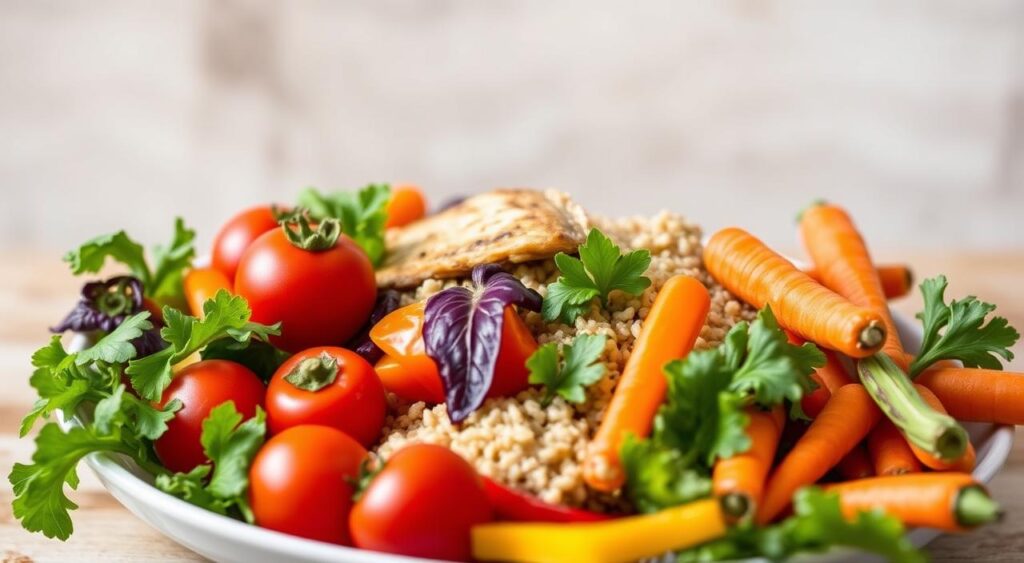Tips to Set and Achieve Long-Term Weight Loss Goals
Ever wondered why so many weight loss plans start with enthusiasm but lose momentum over time? The key to lasting success lies in setting the right goals.
Proven Strategies to Achieve Long-Term Weight Loss
Discover Java Burn – Visit the Official Site Now!
Studies reveal losing 5% of your body weight can lower serious health risks. For instance, a 200-pound person losing 10 pounds in six months is beneficial. Experts say this goal allows for gradual lifestyle changes.
Why are realistic goals important? Trying to lose 50 pounds in a month is too ambitious. SMART goals, like losing 1–2 pounds a week, help build lasting habits.

Now, let’s look at some practical tips. Setting small goals, like 150 minutes of exercise weekly, makes progress feel achievable. A balanced diet is also crucial for healthy weight loss.
Discover BioFit – Your Path to Better Weight Loss!
In the next parts, we’ll share more tips and strategies. We’ll cover setting realistic goals and the importance of a balanced diet. Ready to learn how to lose weight and keep it off? Keep reading!
The Importance of Setting Realistic Weight Loss Goals
Setting realistic weight loss goals is key to losing weight and keeping it off. Goals that are too high can lead to disappointment. But, goals that are achievable keep you motivated and moving forward.
Why Realistic Goals Matter
Realistic goals are important because they help you lose weight safely and keep it off. A study in the Journal of Human Nutrition and Dietetics found that setting specific goals leads to better weight loss over time. Losing 10% of your extra weight can greatly improve your health, showing the value of setting achievable goals.
Fitspresso – The Weight Loss Solution You Need!
People who are obese often set unrealistic goals, which can lead to frustration. A 2001 study showed that these individuals were more likely to feel let down. It’s important to keep track of your weight and adjust your goals regularly to succeed in losing weight.
Examples of Realistic Long-Term Goals
Experts say a good weight loss goal is 1 to 2 pounds a week. This means cutting 500 to 700 calories a day. For example, losing 10 pounds in six months is a realistic goal that helps you stick to your weight loss plan.
The table below shows examples of realistic long-term goals:
| Type of Goal | Recommended Target |
|---|---|
| Weekly Weight Loss | 1-2 pounds |
| Daily Calorie Deficit | 500-700 calories |
| Physical Activity | 150-225 minutes/week |
| Weight Loss in 12 Weeks | 10 pounds |
| Weight Loss in 6 Months | 7% of starting weight |
By setting realistic weight loss goals, you can make a plan that works for you. This plan helps you lose weight effectively and improves your health and happiness.
How to Lose Weight: Understanding the Basics
Losing weight can seem hard, but knowing the basics makes it easier. The main idea is to balance how many calories you eat and burn. This balance is key to losing weight quickly and keeping it off.
Calories In vs. Calories Out
To lose weight fast, you need to eat fewer calories than you burn. This idea, “calories in vs. calories out,” is crucial for any weight loss plan. Studies show that slow weight loss, about 1 to 2 pounds a week, is more likely to last.
“A 5% weight reduction for a person weighing 200 pounds equates to a loss of 10 pounds, significantly lowering the risk for chronic diseases such as heart disease, prediabetes, and type 2 diabetes.”
To lose calories, watch both what you eat and how much you move. Setting achievable goals, like eating 500 fewer calories a day, can lead to good results without stress.
The Role of Exercise in Weight Loss
Exercise is a big part of losing weight. It helps increase the calorie deficit from diet changes, helping you lose weight faster. Even simple activities like walking for 15 minutes, 3 times a week, can be more effective than just saying “I’ll exercise more.”

Combining diet with exercise has many benefits. It helps with calorie loss and also boosts heart health and overall well-being. The 2005 Dietary Guidelines suggest at least 30 minutes of activity daily for health and weight loss support.
Mitolyn – The Secret to a Healthier You!
In short, understanding calories in vs. calories out and adding exercise to your routine are key steps in a successful weight loss plan. By focusing on these basics, you can reach and keep your weight loss goals.
SMART Goals: Specific, Measurable, Action-Based, Realistic, Timely
Setting SMART weight loss goals changes how you reach your fitness goals. With specific measurable goals, you have a clear target. This boosts your motivation and helps you stick to your weight loss plan.
Tips to Set and Achieve Long-Term Weight Loss Goals
U.S. News and World Report says 80 percent of New Year’s resolutions fail by mid-February. This shows how crucial it is to have clear, achievable goals. For example, aim to lose 15 pounds in three months. Break it down into smaller goals like losing six pounds in the first month and four pounds in each of the next two months.
Slim Boost Tea – The Natural Way to Lose Weight!
Those who set specific measurable goals are 30% more likely to achieve them compared to those with vague objectives.
Action-based weight loss strategies keep you moving forward. Start with walking 15 minutes daily for two weeks. Then, increase your walking time by five minutes each week. This goal is measurable and focused on action, helping you track your progress and make changes as needed.
Using resources like Aspire Health Plan can help. It offers access to the Silver&Fit® exercise and healthy aging program, plus a Health Coaching program for personalized support. Working with professionals like Registered Dietitians can increase your success rate by 40%.
Stress management is key in weight loss. High cortisol levels can lead to overeating and less exercise. Setting realistic goals can improve your success rate by 60% and help manage stress better.
Research shows 70% of successful weight loss participants set time-bound goals. This creates a sense of urgency. Also, 80% of people who set measurable goals feel more motivated. Those who track their progress are 33% more likely to reach their goals.
Lastly, focusing on positive actions rather than negative restrictions is better. A survey found 75% of people prefer this approach for health goals. Achieving your SMART weight loss goals can improve your well-being and lifestyle satisfaction by 25%.
Java Burn: The Secret to Weight Loss – Learn More!
Creating a Balanced Diet for Weight Loss
A balanced diet is key for keeping weight off for good. Eating foods high in fiber and low in calories helps. Avoiding foods high in sugar and fat is also important. This way, you can enjoy your meals while losing weight.

Foods to Include in Your Diet
To keep your diet balanced for weight loss, eat a variety of foods. Make sure half your plate is vegetables. Carbs should only be one-third of your meal. Include lean proteins, whole grains, and healthy fats.
Try to eat fish twice a week, with one portion being oily fish. Drink six to eight cups of water, tea, coffee, and soup every day.
Here is a helpful table to guide your balanced diet weight loss efforts:
| Food Group | Recommended Intake | Examples |
|---|---|---|
| Vegetables | At least 5 portions daily | Broccoli, spinach, carrots, peppers |
| Fruits | At least 5 portions daily | Apples, berries, oranges, bananas |
| Whole Grains | Make up one-third of meal | Brown rice, quinoa, oats, whole-wheat bread |
| Lean Proteins | Include in every meal | Chicken, turkey, fish, beans, lentils |
| Healthy Fats | Moderately consumed | Avocado, olive oil, nuts, seeds |
| Fluids | 6-8 cups daily | Water, tea, coffee, soup |
Foods to Avoid When Losing Weight
Stay away from foods high in sugar, fat, and processed ingredients. These can lead to weight gain. Also, serve your own portion at meals and measure ingredients like oil and butter to keep portion sizes right.
Sample Meal Plans
Structured meal plans can keep your diet balanced and varied. The Mayo Clinic Diet suggests meals with 1,200 calories, like overnight oats and Tuscan white bean soup. Using smaller plates and bowls helps with portion control.
Want to Lose Weight? Try BioFit Today!
Here is a sample daily meal plan to get you started:
| Time | Meal | Details |
|---|---|---|
| Breakfast | Overnight Oats | Oats with chia seeds, almond milk, and mixed berries |
| Lunch | Tuscan White Bean Soup | White beans, kale, tomatoes, herbs |
| Evening Snack | Fruit Salad | Mixed fruit with a touch of yogurt |
| Dinner | Sheet-pan Roast Chicken | Chicken breast, assorted vegetables, olive oil |
Following these tips can help you lose weight and improve your health. Add these strategies to your daily routine for a successful weight loss journey.
The Ultimate Guide to Achieving Your Weight Loss Goals
Losing weight and keeping it off needs a mix of diet, exercise, and lifestyle changes. Many start their weight loss journey but struggle to keep it up. The National Weight Control Registry (NWCR) tracks over 10,000 people who have lost and kept off weight. This gives us insights into making a good plan.

Diet is key in the ultimate weight loss guide. The American Heart Association says women should limit added sugar to six teaspoons a day. Men should limit it to nine. But, the average American eats about 17 teaspoons daily. Cutting down on sugar can help you lose weight and lower diabetes risk.
Exercise is also vital for weight loss. The NWCR found that people who keep off weight do about 60 minutes of activity daily, often walking. The American Heart Association also stresses the importance of physical activity for health. Exercise burns calories and helps control hunger, aiding in weight loss.
Behavioral and psychological aspects of weight loss are also crucial. Emotional eating is a big obstacle. Eating high-fiber foods like fruits, vegetables, and whole grains can help manage hunger. Studies show eating more calories in the morning helps with weight management.
Looking at your sleep is also important. Aim for about eight hours of quality sleep each night. Good sleep helps control hunger and motivation, key for weight loss. Regularly checking your weight can help catch small gains and make adjustments.
Small, steady changes in diet can make a big difference. Eating the right amounts of vegetables, proteins, healthy oils, and grains is essential. The NHS Weight Loss Plan app helps set realistic goals and track progress over 12 weeks. It follows the principles of any good weight loss guide.
In conclusion, losing weight requires a complete plan that includes diet, exercise, emotional well-being, and sleep. By making small, consistent changes and using tools and support, you can create a lasting weight loss plan. This guide offers the basics for a successful weight loss journey, helping you lose and keep off weight for good.
Effective Weight Loss Strategies
For effective weight loss, try a mix of regular exercise, healthy eating, and using tech to track your progress. These steps help you lose weight in a way that lasts and boosts your health.
Incorporating Physical Activity
Regular exercise is key for losing weight. Try to do at least 30 minutes of aerobic activity most days. You can walk, jog, swim, or cycle.
Also, do strength training two times a week. This builds muscle, which helps with weight loss and keeping it off. Studies show that those who exercise regularly do better at keeping weight off.
Healthy Eating Habits
Eating right is vital for losing and keeping off weight. Eat lots of whole grains like brown rice and whole-wheat bread. Try to have four servings of veggies and three servings of fruits every day.
High-fiber foods like legumes, fruits, and veggies make you feel full and might cut down on calories. Eating slowly and without distractions helps prevent eating too much.
Using Technology to Track Progress
Using tech to track your weight loss can be very helpful. Tools like pedometers, fitness trackers, and apps can monitor your activity and food. This gives you motivation and insights.
Fitspresso for Weight Loss – Click to Discover More!
Tracking your progress regularly can lead to lasting changes in your behavior. It also helps you stay motivated. Plus, keeping an eye on what you eat can lead to eating less and losing weight.

| Strategy | Details | Benefits |
|---|---|---|
| Physical Activity | 30 mins of aerobic exercise most days, strength training twice a week | Burns calories, builds muscle, supports weight maintenance |
| Healthy Eating Habits | Whole grains, vegetables, fruits, high-fiber foods | Increases satiety, reduces calorie intake, promotes overall health |
| Weight Loss Technology | Tracking devices, apps for diet and exercise logging | Monitors progress, provides motivation, identifies areas for improvement |
The Role of Mindset in Long-Term Weight Management
A weight loss mindset can greatly impact your weight loss journey. It’s not just about losing weight, but keeping it off too. Studies show that those who see setbacks as learning chances are more likely to keep weight off.
Exercise is good for both body and mind. It boosts mood and helps with depression and anxiety. This mental boost is key to a successful weight loss mindset. Eating mindfully also helps by making food a positive part of life, not just fuel.

Chronic stress can lead to weight gain, especially around the belly, says the CDC. So, managing stress is crucial for weight loss. Cognitive-behavioral therapy (CBT) helps with emotional eating, leading to better weight loss results.
Setting achievable goals helps avoid frustration and keeps you on track. Celebrating small wins boosts confidence and mental strength. Research shows self-compassion and setting small goals work better than strict diets for a healthy lifestyle.
Most weight loss programs focus too much on numbers and not enough on motivation. But, keeping participants’ autonomy is just as important. This shift can create a more supportive environment for lasting weight loss.
The pandemic has made many focus on weight loss, with 42 percent aiming to lose weight in 2021. The average weight gain was 29 pounds, showing the need for mental strategies. Self-compassion and mindful eating can help fight pandemic-related weight gain.
How to Stay Motivated on Your Weight Loss Journey
Keeping up motivation during weight loss can be tough. But, using smart strategies can help keep you motivated and moving forward.
Setting Short-Term Milestones
Short-term goals are key to staying motivated. Breaking down big goals into smaller ones makes the journey easier. Research shows celebrating small wins boosts your commitment by 30%.
Mitolyn Reviews – See What Users Are Saying!
Try to lose 1 to 2 pounds a week. For example, if you’re 180 pounds, aiming to lose 9 to 18 pounds is a good goal.
Rewarding Yourself
It’s also important to reward yourself for reaching milestones. Positive feedback can really help keep you going. Studies say celebrating treats, like cake, helps you stay on track more than feeling guilty.
Don’t just think food rewards. New workout clothes, a book, or a fun day out can also motivate you.
Finding a Support System
Having people to support you is crucial. Social support can double your chances of losing weight. Whether it’s family, friends, or a group, having someone to encourage you is vital.
Getting help from dietitians or fitness experts can also boost your confidence. Remember, you’re not alone, and sharing your goals can make you more accountable.

Top Mistakes That Sabotage Weight Loss and How to Fix Them
Many people struggle with weight loss because of common mistakes. By understanding and fixing these errors, you can achieve your goals.
Skipping breakfast is a big mistake. It can make you hungrier later, leading to more snacking and bigger meals. Eating breakfast helps keep your weight healthy.
Another issue is mindless snacking. These small bites can add up quickly. It’s important to track what you eat to control calories. Eating small meals throughout the day can help manage hunger and weight.
Choosing low-fat products can also backfire. They might make you eat more because you think they’re healthier. Fancy coffees and drinks can have a lot of calories, so watch what you drink.
Not drinking enough water can slow down your metabolism. Drinking water with meals is key. Also, getting enough calcium from dairy can help burn fat.
Setting unrealistic goals can be discouraging. Aim to lose 1-2 pounds a week for a more achievable goal. This approach is backed by research.
Eating fast food too often is another mistake. A study showed that those who ate fast food more than twice a week gained 10 pounds more than others.
Ultra-processed foods are bad for weight loss. They’re full of unhealthy ingredients. Cooking with whole foods can help you make better choices.
Stress can also hurt your weight loss efforts. It can make you hungrier and store more fat. Chronic stress can increase belly fat by 10-15%.
Finally, distractions while eating can lead to eating too much. Try to eat without distractions. Eating protein in most meals can also help with weight loss.
By avoiding these mistakes and focusing on healthy habits, you can improve your weight loss journey. Adjust your diet, set realistic goals, and stay consistent for better results.
Crash Diets vs. Sustainable Weight Loss: What Works Best?
Many people try crash diets for fast weight loss. These diets cut calories to 800-1,200 a day. A study showed that 60% of people on 600 calories a day for eight weeks lost 15kg and got better with type 2 diabetes.
But crash diets have big risks. They can make you store more fat and lower your metabolism. A 12-week study found that people lost nearly 11kg but gained 3kg back soon. Also, about 80% of crash diets fail, leading to weight gain.
Sustainable weight loss is about slow, steady changes. Balanced diets help you lose 0.5 to 1kg a week. High-protein diets can also boost your metabolism by 11-14%.
Choosing sustainable weight loss avoids metabolic problems. It also helps you build healthier habits. Adding more exercise is key to keeping weight off. People on balanced diets often feel less hungry and eat better, leading to lasting results.
It’s important to think about the long-term effects of crash diets versus sustainable methods. Here’s a comparison:
| Crash Diets | Sustainable Weight Loss | |
|---|---|---|
| Calorie Intake | 600-1,200 calories/day | 1,500-2,000 calories/day |
| Weight Loss Speed | Rapid (up to 15kg in 8 weeks) | Gradual (0.5 – 1kg per week) |
| Health Risks | High cortisol, muscle loss, lowered metabolic rate | Balanced, improved overall health, consistent weight management |
| Long-Term Success | Low (80% regain weight) | High with maintained habits |
While crash diets offer quick fixes, sustainable weight loss is healthier and lasts longer. Focus on natural weight loss methods for better results.
Best Exercises for Fast and Effective Weight Loss
Adding a variety of fast weight loss exercises is key for the best results. Effective workouts should mix cardio and strength training. This boosts metabolism, increases muscle, and burns fat efficiently.
Cardio Workouts
Cardio is essential for losing weight. Here are some top cardio exercises:
- Running and Jogging: A 140-pound person burns 10.8 calories per minute jogging and 13.2 calories running. These are great for burning belly fat linked to diseases.
- Cycling: Cycling can burn 400 to 750 calories per hour, based on weight, speed, and type. It’s great for fitness and lowers heart disease and cancer risks.
- Swimming: Swimming at a moderate pace burns 9 calories per minute for a 140-pound person. It reduces body fat and improves heart health.
- Jumping Rope: This intense workout burns more calories than walking on a treadmill. It’s excellent for losing weight.
Strength Training
Strength training is vital for muscle building and boosting metabolism. Try these exercises:
- Weight Training: A 140-pound person burns 7.6 calories per minute during weight training. A study showed a 7.4% increase in metabolic rate after six months.
- High-Intensity Interval Training (HIIT): HIIT burns 25-30% more calories per minute than other exercises. It keeps your body burning fat for up to 24 hours after.
- Yoga: Doing yoga once a week for 30 minutes can lead to weight loss and lower BMI. A study found women lost an average of 1.5 inches from their waist in 12 weeks.
Combining Different Types of Exercise
Mixing cardio and strength training is best for fat burning and muscle building. Here’s how to balance your workouts:
- Blend Cardio and Strength: Aim for 300 minutes of moderately intense activity weekly. Mix cardio like running, cycling, and swimming with strength training like weight lifting or HIIT.
- Flexible Scheduling: Alternate between cardio and strength training days. This avoids overtraining and reduces injury risk while ensuring fitness gains.
- Active Recovery: Include low-intensity activities like walking or light yoga on rest days. This keeps calorie burn steady while allowing muscles to recover.
Weight Loss Medications: Do They Really Work?
Weight loss medications are getting more popular for those trying to lose weight. They can help a lot, but it’s important to know their good and bad sides.
Types of Weight Loss Medications
There are many types of weight loss medications. Each one works in a different way and is for different needs. Here are some common ones:
- Semaglutide (Wegovy): Users can lose up to 15% of their body weight after 68 weeks.
- Tirzepatide: This drug led to a 20% or more weight loss in a 72-week trial.
- Orlistat (Xenical): People lost an average of 10.3 pounds over six months.
- Phentermine/Topiramate (Qsymia): Users lost an average of 19.4 pounds after one year.
- Naltrexone/Bupropion (Contrave): This combo showed an average weight loss of 11 to 22 pounds in clinical reviews.
- Setmelanotide (Imcivree): About 62% of participants lost at least 10% of their body weight in trials.
Prescription weight loss medications can help people lose a lot of weight. Most users lose 5% to 10% of their body weight. These drugs are for people with a BMI over 30, or over 27 with health problems related to obesity.
Potential Risks and Benefits
The good news about weight loss pills is that they can work well. But, it’s also important to think about the risks of weight loss drugs. Side effects like nausea, diarrhea, and upset stomach can happen, but serious problems are rare. It’s key to have regular blood tests to make sure the medication is safe.
Here’s a detailed table showing how well these medications work and their costs:
| Medication | Average Weight Loss | Cost Per Month |
|---|---|---|
| Semaglutide (Wegovy) | 15% over 68 weeks | $1,000 |
| Tirzepatide | 20% over 72 weeks | $1,000 |
| Orlistat (Xenical) | 10.3 pounds over 6 months | $205 |
| Phentermine/Topiramate (Qsymia) | 19.4 pounds over 1 year | $166 |
| Naltrexone/Bupropion (Contrave) | 11 to 22 pounds | $617 |
| Setmelanotide (Imcivree) | 10% in 62% of users | $3,623.40 |
Talking to a healthcare provider is key to finding the right weight loss medication. They can help make sure the benefits are worth the risks, leading to a safer and more effective weight loss journey.
Tools and Resources to Help You Lose Weight Naturally
Using natural weight loss tools and weight loss resources can really help you reach your weight loss goals. These tools give you the guidance and support you need to stay on track. They make sure you keep moving forward on your weight loss journey.
Studies and experts agree that these tools are key to success. The Centers for Disease Control and Prevention (CDC) says to aim for 1 to 2 pounds of weight loss each week. They also point out that too much sugar is a big problem, so tracking what you eat is important.
Fitness trackers and apps are great for keeping an eye on calories and exercise. They match up with the CDC’s advice of 150 minutes of moderate activity or 75 minutes of vigorous activity each week. These tools give you real-time feedback and help you make healthier choices.
Eating more fiber and enough protein are also important for losing weight. A 2023 study found that a fiber-rich diet helped people lose an average of 7.2 pounds in 16 weeks. Also, doing muscle-strengthening exercises is key, as shown in studies that found whey protein helps build muscle strength.
Managing stress, having social support, and planning meals are also crucial. Stress can make you gain weight, especially around your belly. A good stress management program can help you feel less stressed and eat better.
“Social support can significantly impact weight loss success. The U.S. Surgeon General’s 2023 advisory noted that social disconnection is as harmful as smoking 15 cigarettes per day.”
Here’s a list of some top natural weight loss tools:
| Weight Loss Tool | Function | Benefits |
|---|---|---|
| Fitness Trackers | Monitor physical activity and calorie burn | Enhanced motivation and activity tracking |
| Nutritional Apps | Track daily calorie and nutrient intake | Better dietary choices and awareness |
| Support Groups | Provide communal support and advice | Increased motivation and shared experiences |
| Stress Management Programs | Reduce stress-related weight gain | Healthier mental state and eating habits |
| Meal Planning Tools | Organize and plan nutritious meals | Prevent unhealthy last-minute choices |
In summary, using a mix of these weight loss resources supports a healthy lifestyle. They help with exercise, diet, and mental health. These tools offer a complete package for natural weight loss and keeping it off.
Conclusion
Successful weight loss comes from setting realistic goals, eating well, staying active, and having support. Looking at weight loss journeys shows that keeping weight off long-term needs ongoing effort. It’s about making lasting changes.
Our research involved over 600 people aged 18 to 50 with BMIs from 28 to 40. They got help for a year, learning to make plans that fit their genes and health. This shows how important it is to tailor weight loss plans to fit each person’s needs.
But, keeping weight off is hard. Studies say up to 80% of people gain back the weight they lost. Life changes, health issues, and genetics are big obstacles. Yet, those who stay committed and positive do better in the long run.
Want to Shed Pounds Naturally? Try Slim Boost Tea!
Every weight loss journey is different. Think about what you need and what works for you. Keep learning and stay motivated to reach and keep your weight loss goals.
FAQ
Why is it important to set realistic weight loss goals?
Setting realistic weight loss goals is key. It makes sure you can keep it up without harming your health. For instance, aiming to lose 10 pounds in six months is better than trying to do it in two weeks.
What are some effective strategies for losing weight fast?
To lose weight quickly, mix regular exercise, a balanced diet, and tracking tools. Daily activities like walking or strength training boost calorie burn and health.
What are SMART goals in weight loss?
SMART goals are Specific, Measurable, Action-based, Realistic, and Timely. They help you stay focused and on track. For example, walking 10,000 steps a day is clear and doable.
Which foods should I include in my diet for weight loss?
Eat foods high in fiber and low in calories, like fruits and veggies. Stay away from sugary and fatty foods for a healthier diet.
How can I stay motivated throughout my weight loss journey?
Staying motivated is tough, but setting small goals and rewarding yourself helps. Celebrate your wins and surround yourself with supporters.
What are some top mistakes that sabotage weight loss?
Common mistakes include not sticking to a diet, overestimating calorie burn, and setting unrealistic goals. Fix these by adjusting your diet and setting achievable goals.
Are crash diets effective for weight loss?
Crash diets might seem quick, but lasting weight loss comes from gradual lifestyle changes. Eat well and exercise regularly for better results.
What types of exercises are best for fast and effective weight loss?
Mix cardio and strength training for best results. These workouts boost metabolism, build muscle, and burn fat efficiently.
Do weight loss medications really work?
Medicamentos podem ajudar na perda de peso, mas eles têm riscos. Sempre converse com um médico para ter certeza de que eles são adequados para você.
What tools and resources can help with natural weight loss?
Use apps, fitness trackers, and support groups for guidance and motivation. They help you stay on track with natural weight loss.





